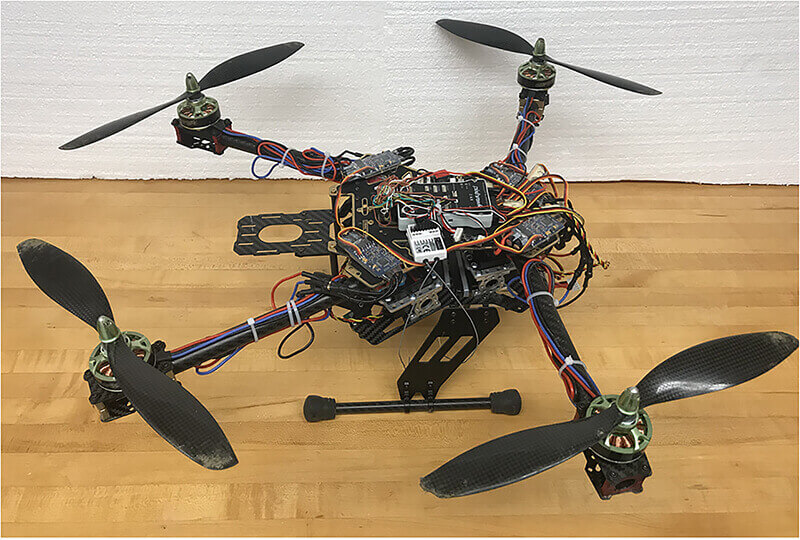April 16, 2019
Up in arms: Insect-inspired arm technology aims to improve drones

A Purdue University researcher has come up with a patented design for drones, or unmanned aerial vehicles, that works in windy conditions, is more energy-efficient and can handle a larger payload. (Image provided)
Patented unmanned aerial vehicles fly in windy conditions
WEST LAFAYETTE, Ind. – A drone delivery is great – on a perfect, sunny day. But what about when it’s windy? Most drones are not able to withstand wind because of their fixed-arm design.
A Purdue University researcher has come up with a patented design for drones, or unmanned aerial vehicles, that works in windy conditions, is more energy-efficient and can handle a larger payload.
“Our drone design was inspired by the wings and flight patterns of insects,” said Xiumin Diao, an assistant professor in Purdue’s School of Engineering Technology. “We created a drone design with automatic folding arms that can make in-flight adjustments.”
Diao said the design provides drones with improved stability in windy conditions because the folding arms can move and change the center of gravity of the device during flight. He said the design also makes drones more energy efficient because the movable-arm technology allows for the use of the full range of rotor thrust. The technology is published in the ASME Journal of Dynamic Systems, Measurement and Control.
“The drones on the market now have fixed arms and that greatly reduces their maximum payload capacity when the payload is offset their center of gravity,” Diao said. “Our design allows a larger payload because the movable arms can liberate part of rotor thrust to fight the weight on the overall device.”
Diao said the foldable arms also can help in search-and-rescue operations using drones because they can more effectively navigate the air conditions in ravaged areas and morph by moving the arms to go through narrow spaces.
A record of more than $700 million was invested in the drone industry in 2018 as military, government and consumer markets saw increased demand.
Diao worked with the Purdue Office of Technology Commercialization to patent his device. They are looking for additional researchers and partners to license the technology.
Their work aligns with Purdue's Giant Leaps celebration, celebrating the global advancements in sustainability as part of Purdue’s 150th anniversary. Sustainability, including energy-efficient devices, is one of the four themes of the yearlong celebration’s Ideas Festival, designed to showcase Purdue as an intellectual center solving real-world issues.
About Purdue Office of Technology Commercialization
The Purdue Office of Technology Commercialization operates one of the most comprehensive technology transfer programs among leading research universities in the U.S. Services provided by this office support the economic development initiatives of Purdue University and benefit the university's academic activities. The office is managed by the Purdue Research Foundation, which received the 2016 Innovation and Economic Prosperity Universities Award for Innovation from the Association of Public and Land-grant Universities. For more information about funding and investment opportunities in startups based on a Purdue innovation, contact the Purdue Foundry at foundry@prf.org. For more information on licensing a Purdue innovation, contact the Office of Technology Commercialization at otcip@prf.org. The Purdue Research Foundation is a private, nonprofit foundation created to advance the mission of Purdue University.
Writer: Chris Adam, 765-588-3341, cladam@prf.org
Source: Xiumin Diao, diaox@purdue.edu
Abstract
Optimize Energy Efficiency of Quadrotors Via Arm Rotation
Hao Xiong, Jin Hu and Xiumin Diao
doi:10.1115/1.4043227
Quadrotors have been used in many areas such as cargo transportation, agriculture, and search and rescue. The low energy density of power sources and the low energy efficiency of quadrotors have prevented quadrotors from a wider range of applications where a large payload has to be carried or long flight time is required. This paper optimizes the energy efficiency of a quadrotor via rotating its arms to proper positions calculated based on the dynamics model of the quadrotor and the power–thrust curve of rotors. The conditions that a quadrotor in steady-state can achieve the optimal energy efficiency are mathematically derived and the energy efficiency of a quadrotor in various scenarios is analyzed. Based on the analysis, an arm-rotation approach is proposed to optimize the energy efficiency of a quadrotor with a center-of-gravity offset in steady hovering. It is shown with simulation that an example quadrotor with rotatable arms can save up to 13% of energy. Experiments show that the same example quadrotor can save even more energy in practice, owing to the byproduct of the arm-rotation

